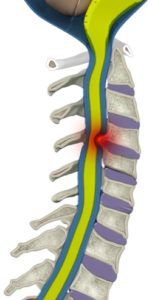The compression of nerves in the neck is called cervical myelopathy. The additional pressure results in impaired motor skills, stiff neck, mild to severe pain, loss of balance, and troubled gait.
MRI is the most common way to diagnose cervical myelopathy, and in most cases, Spine Decompression Surgery is the most effective way to treat it.
What Causes A Cervical Myelopathy
The spine consists of 33 vertebrae, out of which 7 are present in the cervical region, along with 8 nerve roots and 6 interverbal discs. The spinal cord—the soft cord that is the backbone of all the brain’s commands and instructions—is protected inside of this bony structure.
When the spinal cord in the cervical region becomes compressed, the condition is called cervical myelopathy. Since the spinal cord is essential for the brain’s control of your motor skills and gait, they naturally get affected.
While aging and gradual spinal degeneration can cause cervical myelopathy, there are other conditions that can cause this condition:
- Ossification: Patients experience hardening of the ligaments—most commonly, the posterior ligaments—around the spinal region. This is where the soft tissue that connects vertebra to vertebra undergoes bone tissue formation, causing friction and pain. As the hard bone gradually grows, it creates pressure on the nerves.
- Other causes include rheumatoid arthritis in the neck, infections in the spine, spine trauma, whiplash, cancer or tumors in the spine
What Are The Symptoms of Cervical Myelopathy
Although cervical myelopathy originates in the neck, where you’ll experience much pain, other symptoms can also indicate cervical myelopathy. These usually occur below the cervical region, where the nerves are compressed.
Symptoms in the neck include:
- Mild to severe pain
- Not being able to move your neck
- Stiff neck
Additionally, if the condition progresses unchecked, patients experience sharp pains that originate in the cervical region and travel down to other parts of the spine.
Other symptoms that don’t materialize in the neck include:
- Weakness in the limbs
- Clumsiness
- Poor coordination of limbs
- Problems in maintaining balance
- Inability to handle minute objects such as pencils and knives
- Numb fingers accompanied by tingling
If you’re experiencing neck pain, consult with a doctor to ensure it’s not muscular pain.
Cervical Spondylotic Myelopathy
As we age above 50 years old, our spinal canal narrows and the spine degenerates, causing Cervical Spondylotic Myelopathy.
Additionally, people who have narrow spinal canals may experience Cervical Spondylotic Myelopathy earlier than usual. Other causes may include herniated discs, bulging in the neck, and bone spurs.
How Is A Cervical Myelopathy Diagnosed?
Early diagnosis is the key to finding effective relief from cervical myelopathy. A regular diagnosis at Houston Neurosurgery & Spine includes:
- Physical examination accompanied by measurement of muscle strength and evaluation of reflexes
- Tests that include: MRI, CT scan, X-rays, myelogram
- Electrical tests for the determination of how well nerves in the limbs are communicating and coordination with the brain.
What Are The Treatment Options For A Cervical Myelopathy
Depending on the severity of the condition, you can undergo surgical or non-surgical treatments for cervical myelopathy.
Non-Surgical Treatments
- Physical therapy
- Collar brace
Spine Fusion
Surgeons can operate on your spine to join multiple bones in the spine for relief from cervical myelopathy. The spinal cord is made up of vertebrae, each separated and cushioned by intervertebral discs, and the soft spinal cord lies inside.
Conditions such as arthritis cause these intervertebral discs to stop cushioning, causing the vertebrae to move abnormally or against each other, resulting in pain, immobility, etc.
In spine fusion, our surgeons substitute the intervertebral discs with bone-like grafts. At Houston Neurosurgery & Spine, we perform minimally invasive spine fusion, with a small incision under anesthesia so your recovery time is considerably shorter as compared to traditional surgeries.
Surgical Treatment
For complete elimination of the problem and the prevention of its worsening, surgery is recommended. These include:
- Laminoplasty
- Decompression surgery
- Spine fusion.
Surgeons operate anteriorly or posteriorly through the neck depending on the particular condition.
Recovery
You might experience neck pain in the weeks following the surgery. Many patients say that they can’t sit or stand in the same position for long periods and need pain medication to manage the discomfort. Physiotherapy is often recommended to restore limb mobility and help strengthen your muscles. You will fully recover from the surgery after 8 weeks.
Book an appointment with Houston Neurosurgery & Spine for a complete diagnosis and prognosis.

